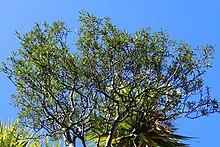| Pittosporum turneri | |
|---|---|
 | |
| Scientific classification | |
| Kingdom: | Plantae |
| Clade: | Tracheophytes |
| Clade: | Angiosperms |
| Clade: | Eudicots |
| Clade: | Asterids |
| Order: | Apiales |
| Family: | Pittosporaceae |
| Genus: | Pittosporum |
| Species: | P. turneri |
| Binomial name | |
| Pittosporum turneri Petrie | |
Pittosporum turneri, commonly called Turner's kohuhu or the tent pole tree, is a species of plant in the Pittosporaceae family.[2] It is endemic to New Zealand.[3] P. turneri was first described by Donald Petrie in 1925.[4] The species flowers between the months of October to December.[4] P. turneri is threatened by possums.[5] It is regarded as being Nationally Vulnerable.[6]
References
- ^ de Lange, P.J. 1998. Pittosporum turneri. 2006 IUCN Red List of Threatened Species. Downloaded on 23 August 2007.
- ^ de Lange, Peter (4 September 2014). "Pittosporum turneri". www.nzpcn.org.nz. New Zealand Plant Conservation Network. Retrieved 31 May 2019.
- ^ "Pittosporum turneri Petrie". www.nzor.org.nz. Manaaki Whenua Landcare Research. Retrieved 31 May 2019.
- ^ a b "Pittosporum turneri". www.nzflora.info. Retrieved 31 May 2019.
- ^ Ecroyd, C. E. (1994). "Regeneration of Pittosporum turneri communities" (PDF). Conservation Advisory Science Notes. 99: 1–34 – via Department of Conservation.
- ^ Heath, Peter (2 December 2013). "Mass planting boosts rare tree numbers by 10 percent". www.forestlifeforce.org.nz. Forest Lifeforce Restoration Trust. Retrieved 31 May 2019.
